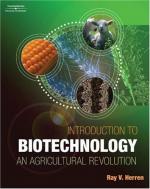|
This section contains 339 words (approx. 2 pages at 300 words per page) |
Transgenic plants are produced when a gene from one plant is inserted into the genome of another. For the gene to work properly in the transgenic plant, it must be engineered to have a promoter before its start codon (to turn it on) and a terminator after its end (to turn it off). Generally the gene also needs some deoxyribonucleic acid (DNA) at either end that will allow it to be inserted into the host genome. The transfer DNA (tDNA) from the bacterial microbe Agrobacterium is used routinely for this purpose. Also required is an antibiotic resistance gene that will allow the transgenic plant cells to be recovered from a mixture with untransformed cells. In a typical project, the desired gene is engineered with the correct elements, placed in a plasmid vector, and then inserted into Agrobacterium cells. Agrobacterium is then used to infect the plant cells with the plasmid vector. The tDNA allows the desired gene and the antibiotic resistance gene to be incorporated into the plant cell's genome. The transgenic cells are selected using the antibiotic in a tissue culture medium; only cells having antibiotic resistance as a result of transformation will survive on this medium. Finally, the transgenic cells are manipulated with the hormones in the tissue culture medium to regenerate whole transgenic plants. To be sure that the gene is inserted and is functioning, botanists will check for the presence of inserted DNA using a Southern blot and will confirm the presence of modified ribonucleic acid (RNA) with a Northern blot. Development of an expected phenotype in mature plants can also confirm the insertion.
See Also
Breeding; Genetic Engineer; Genetic Engineering; Molecular Plant Genetics; Tissue Culture.
Bibliography
Hopkins, W. G. Introduction for Plant Physiology, 2nd ed. New York: John Wiley & Sons, 1999.
Raven, Peter. H., Ray F. Evert, and Susan E. Eichhorn. Biology of Plants, 6th ed. New York: W. H. Freeman and Co., 1999.
Watson, J. D., M. Gilman, J. Witkowski, M. Zoller. Recombinant DNA, 2nd ed. New York: W. H. Freeman and Company, 1992.
|
This section contains 339 words (approx. 2 pages at 300 words per page) |


